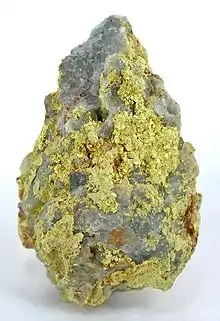Ferrimolybdite
Ferrimolybdite is a hydrous iron molybdate mineral with formula: Fe3+2(MoO4)3·8(H2O)[2] or Fe3+2(MoO4)3·n(H2O).[1] It forms coatings and radial aggregates of soft yellow needles which crystallize in the orthorhombic system.
| Ferrimolybdite | |
|---|---|
 Ferrimolybdite crystals from the Kingman District, Mohave County, Arizona | |
| General | |
| Category | Molybdate mineral |
| Formula (repeating unit) | Fe3+2(MoO4)3·8(H2O) or Fe3+2(MoO4)3·n(H2O) |
| Strunz classification | 7.GB.30 |
| Crystal system | Orthorombic |
| Crystal class | Dipyramidal (mmm) H-M symbol: (2/m 2/m 2/m) |
| Space group | Pmmn |
| Unit cell | a = 6.665, b = 15.423 c = 29.901 [Å]; Z = 8 |
| Identification | |
| Color | Canary-yellow, straw-yellow, greenish yellow |
| Crystal habit | Acicular tufted to radial aggregates; powdery, earthy |
| Cleavage | Distinct on {001} |
| Fracture | Uneven |
| Mohs scale hardness | 1-2 |
| Luster | Adamantine, silky, earthy |
| Streak | Light yellow |
| Diaphaneity | Transparent to translucent |
| Specific gravity | 2.99 |
| Optical properties | Biaxial (+) |
| Refractive index | nα = 1.720 - 1.810 nβ = 1.730 - 1.830 nγ = 1.850 - 2.040 |
| Birefringence | δ = 0.130 - 0.230 |
| Pleochroism | X = Y = clear to nearly colorless; Z = dirty gray to canary-yellow |
| 2V angle | 26° to 32° (calculated) |
| References | [1][2][3] |
Discovery and occurrence
It was first described in 1914 for an occurrence in the Alekseevskii Mine in the Karysh River Basin, Khakassia Republic, Siberia, Russia.[1] It was named for its composition (ferric iron and molybdenum).
It occurs as an oxidation product of molybdenum bearing ore deposits. Associated minerals include: molybdenite, pyrite and chalcopyrite.[2]
References
This article is issued from Wikipedia. The text is licensed under Creative Commons - Attribution - Sharealike. Additional terms may apply for the media files.